
Campanula is one of several genera of flowering plants in the family Campanulaceae commonly known as bellflowers. They take both their common and scientific names from the bell-shaped flowers — campanula is Latin for "little bell".

The family Campanulaceae, of the order Asterales, contains nearly 2400 species in 84 genera of herbaceous plants, shrubs, and rarely small trees, often with milky sap. Among them are several familiar garden plants belonging to the genera Campanula (bellflower), Lobelia, and Platycodon (balloonflower). Campanula rapunculus and Codonopsis lanceolata are eaten as vegetables. Lobelia inflata, L. siphilitica and L. tupa and others have been used as medicinal plants. Campanula rapunculoides may be a troublesome weed, particularly in gardens, while Legousia spp. may occur in arable fields.

Campanula rotundifolia, the harebell, Scottish bluebell, or bluebell of Scotland, is a species of flowering plant in the bellflower family Campanulaceae. This herbaceous perennial is found throughout the temperate regions of the northern hemisphere. In Scotland, it is often known simply as bluebell. It is the floral emblem of Sweden where it is known as small bluebell. It produces its violet-blue, bell-shaped flowers in late summer and autumn.

Campanula carpatica, the tussock bellflower or Carpathian harebell, is a species of flowering plant in the family Campanulaceae.
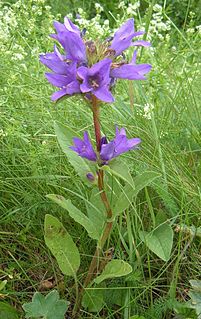
Campanula glomerata, known by the common names clustered bellflower or Dane's blood, is a species of flowering plant in the genus Campanula, belonging to the family Campanulaceae. It is the county flower of Rutland, England.
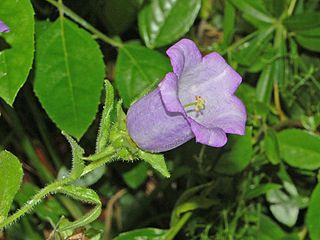
Campanula medium, common name Canterbury bells, is an annual or biennial flowering plant of the genus Campanula, belonging to the family Campanulaceae. In floriography, it represents gratitude, or faith and constancy.
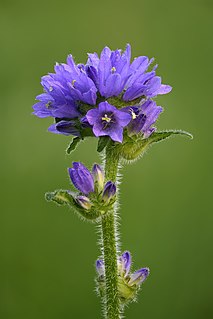
Campanula cervicaria, the bristly bellflower, is a species of flowering plant in the bellflower family Campanulaceae. The plant is roughly hairy and the flowers are about 1–2 centimetres (0.4–0.8 in) long, light blue and are grouped together.
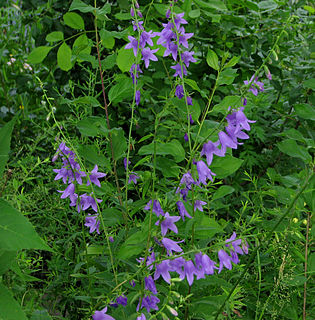
Campanula rapunculoides, known by the common names creeping bellflower, or rampion bellflower, is a perennial herbaceous plant of the genus Campanula, belonging to the family Campanulaceae. In some parts of North America, it is an extremely invasive species.
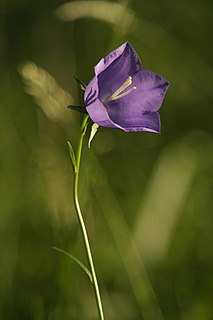
Campanula persicifolia, the peach-leaved bellflower, is a flowering plant species in the family Campanulaceae. It is an herbaceous perennial growing to 1 m. Its flowers are cup-shaped and can be either lilac-blue or white. Its foliage is narrow and glossy with a bright green appearance.

The Circumboreal Region in phytogeography is a floristic region within the Holarctic Kingdom in Eurasia and North America, as delineated by such geobotanists as Josias Braun-Blanquet and Armen Takhtajan.

Campanula rapunculus, common name rampion bellflower, rampion, rover bellflower, or rapunzel, is a species of bellflower (Campanula) in the family Campanulaceae.

Campanula gelida is a stenoendemic, critically endangered species of flowering plant in the bellflower family Campanulaceae. It is a perennial species that grows in the mountains of Hrubý Jeseník in the Czech Republic. It evolved through specialization of an isolated population of Campanula scheuchzeri, an Alpine species, which expanded to the area of the Sudetes during a colder period, probably the last ice age. It is closely related to Campanula bohemica, endemic to the Krkonoše Mountains. Sometimes it is even considered its subspecies and referred to as Campanula bohemica subsp. gelida. They all belong to the group of related species Campanula rotundifolia agg.
Artemisia alaskana, the Alaskan sagebrush or Alaskan wormwood or Siberian wormwood, is a North American species of plants in the sunflower family. It is found in British Columbia, the Yukon, the Northwest Territories, and Alaska. Some authors have considered it as a subspecies as the Russian species A. kruhsiana.

Campanula uniflora, known commonly as arctic bellflower and arctic harebell, is a short and slender rhizomatous perennial in the bellflower family Campanulaceae. It is distributed in arctic North America, including the Rocky Mountains and Greenland, in the Asian part of Beringia and in Iceland, Svalbard, the Scandes Mountains and Novaja Zemlja.

Campanula cochleariifolia, common name earleaf bellflower or fairy's-thimble, is a species of flowering plant in the family Campanulaceae, native to the Pyrenees, Alps, French Massif Central, and Carpathian Mountains of Central Europe. It is a rhizomatous herbaceous perennial growing to 10 cm (4 in). Clumps of bright green leaves produce nodding pale blue bell flowers on wiry stalks.

Vernon Orlando Bailey (1864–1942) was an American naturalist who specialized in mammalogy. He was employed by the Bureau of Biological Survey, United States Department of Agriculture (USDA). His contributions to the Bureau of Biological Survey numbered roughly 13,000 specimens including many new species. Bailey published 244 monographs and articles during his career with the USDA, and is best known for his biological surveys of Texas, New Mexico, North Dakota, and Oregon.
Alaskana is a New Latin term meaning of Alaska, used in taxonomy to denote species indigenous to or strongly associated with Alaska.

Koenigia alaskana is an Asian and North American species of flowering plant in the buckwheat family known by the common names Alaska wild-rhubarb and alpine knotweed.
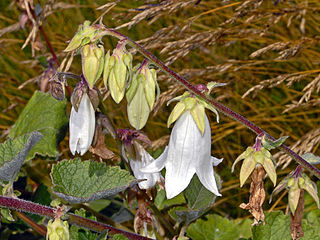
Campanula lanata, the woolly bellflower, is a biennial herb belonging to the family Campanulaceae.
















